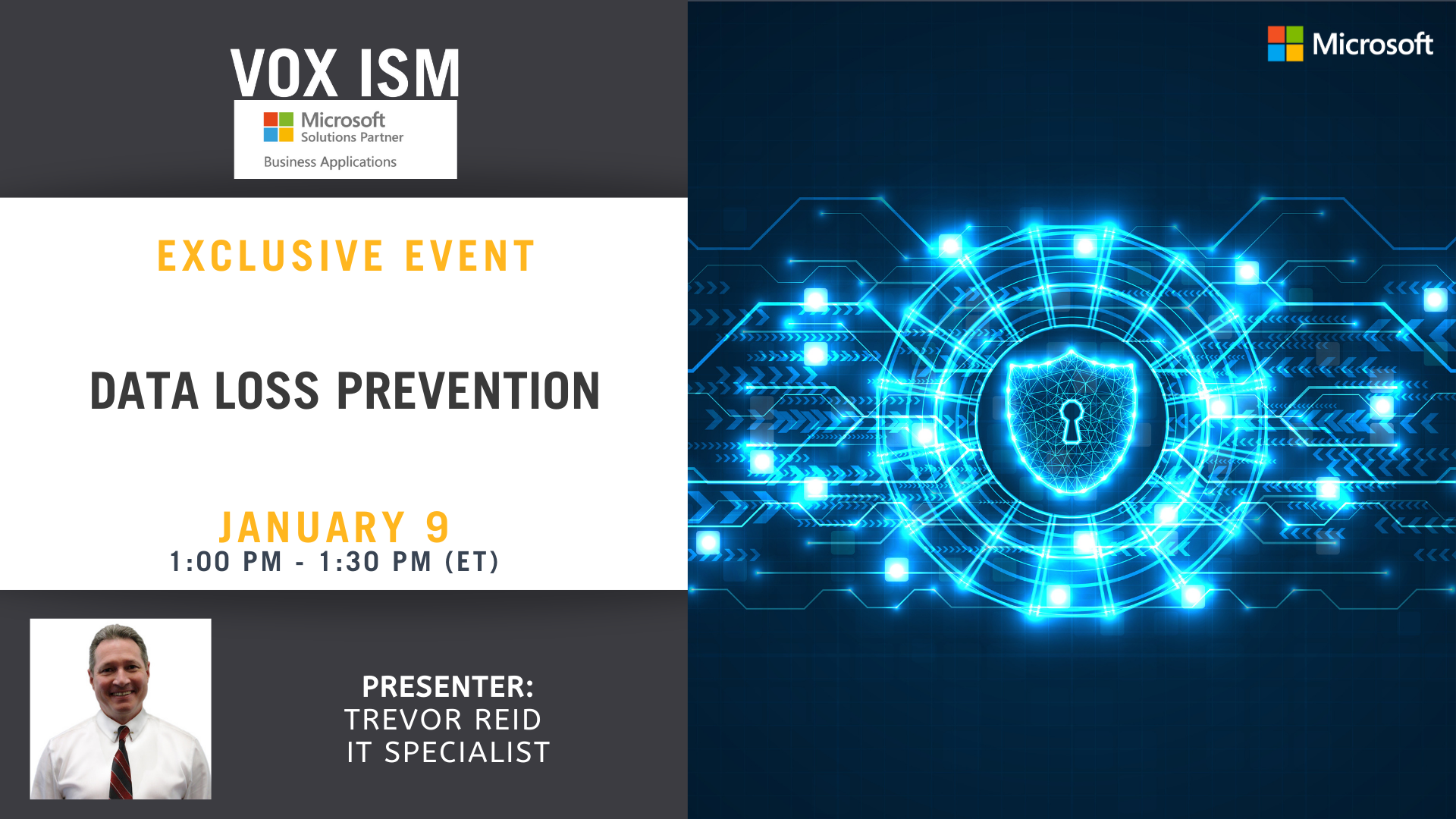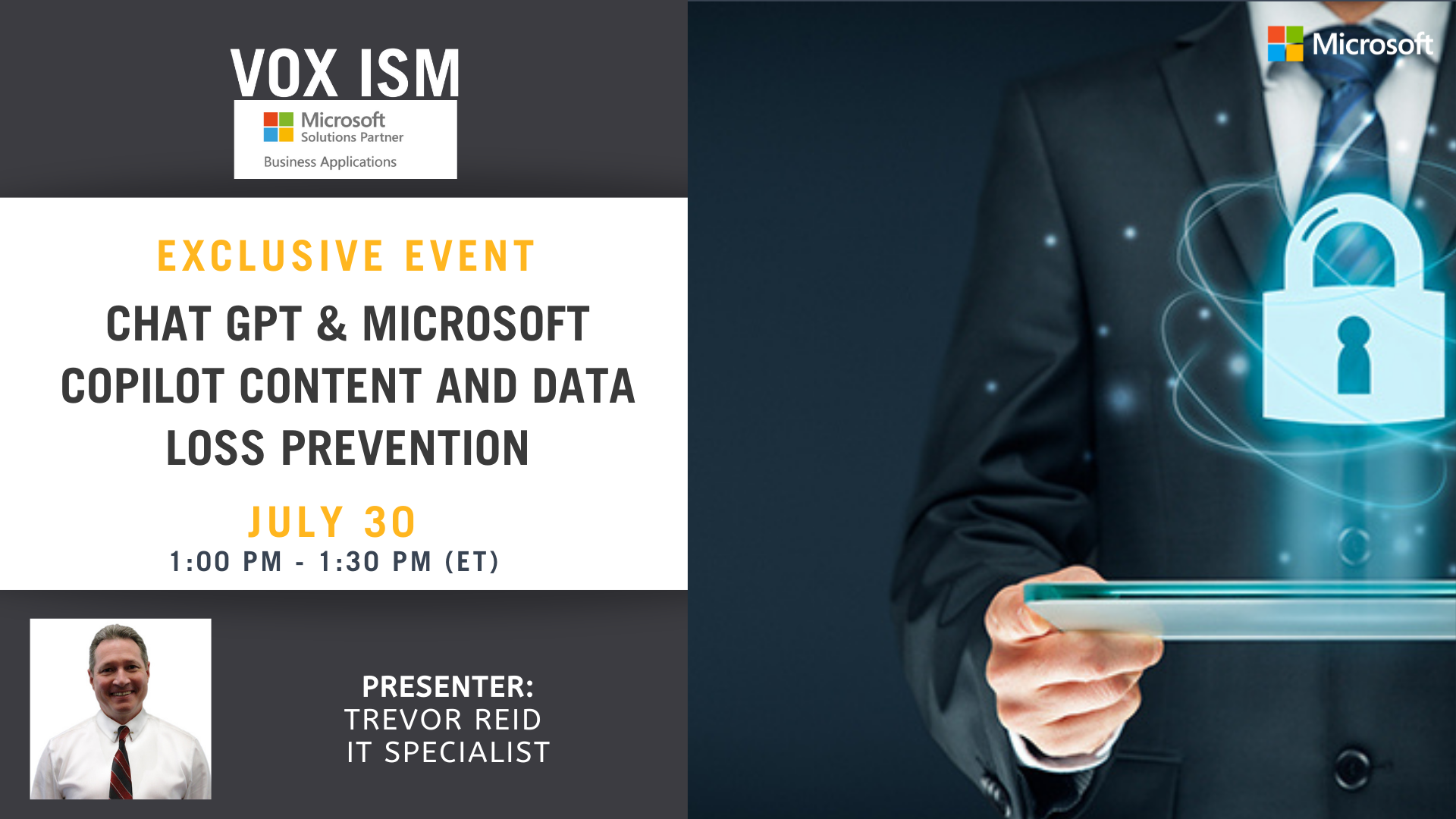Data Loss Prevention
Common causes & effects of Data Loss
What is Data Loss Prevention/DLP Software
How to implement a Data Loss Protection Plan:
- People, Process and Technology, Zero-Trust Policies, using tools you already own, End-point Protection, ect.
- Using Copilot for Microsoft 365 to Improve your Security DLP best practices
Data Loss Protection/DLP Software”
- Kinds of DLP Software & Features
- Top Data Loss Protection Tools
- Microsoft’s DLP Solution
- VOX ISM Tools to help you secure your systems
Infrastructure Security for Copilot
Understanding Copilot\ChatGPT\AI
• Microsoft 365 Copilot v. ChatGPT\Copilot in Browser & Windows11
• How Microsoft 365 Copilot and ChatGPT Work
What you need to know about how Copilot protects your data
• What it can and cannot access
Preparing your Infrastructure for Copilot & AI
• Using Core Microsoft Technologies to better secure your Infrastructure
• Using Copilot to help Assess your Internal Security
• Best Practices in Deploying Copilot for Microsoft 365
Best Practices for Data Protection
• Training & Education – Fostering a cyber-security-aware organizational culture
• Enhancing your End-point protection controls
• Organizational Awareness and Disaster Recovery Planning
• Backup Considerations
Stepping up your Security – Data Loss Prevention for the “AI Generation”
• Microsoft Purview Data Loss Prevention
• Microsoft Data Labelling
Q&A & Closing Remarks
Security Back to Basics
Why Security needs to get “Back to Basics”
Understanding AI (Copilot\ChatGPT) and Security
Microsoft’s Role in Security
Using the Built-in Microsoft Security Tools you already have
Zero-Trust Protocols
Enhancing your End-point protection controls
Backup Considerations – Crucial for On-premise systems
Organizational Security Awareness
Disaster Recovery Planning
Cyber Security in the world of AI
How AI is influencing Cyber Security
How Copilot\ChatGPT work
Microsoft 365 Copilot v. ChatGPT
How Copilot helps keep your data safe
Preparing for the AI Generation & Microsoft’s Role in Cyber-Security
Core Microsoft Technologies for Security
Best Practices for Data Protection with Microsoft Tools
Hardening your Network Security
Understanding AI (Copilot/ChatGPT) and Security
Microsoft’s Role in Cyber Security
Using Built-in Microsoft Security Tools you already have
Zero-Trust Protocols
Enhancing your End-Point Protection Controls
Organizational Awareness and Disaster Recovery Planning
Stepping up your Security – Data Loss Prevention for the AI Generation
- Microsoft Purview Data Loss Prevention
- Microsoft Data Labelling
- Microsoft Entra ID Identity Governance
Back up Considerations – Crucial for On-Premise Systems
ChatGPT & Microsoft Copilot Content and Data Loss Prevention
What is ChatGPT\Copilot?
How Microsoft 365 Copilot and ChatGPT Work
ChatGPT v. Microsoft 365 Copilot and & Copilot in Browser & Windows11
Microsoft 365 Copilot Content & Data Loss Prevention
Tips to get Microsoft 365 Copilot running Securely in your Organization
Steppingup Security: Content and Data Loss Prevention for the “AI Generation”
Getting Started with Microsoft 365 Copilot
Top Cyber Security Trends to adopt in 2024
- AI and its Role in Cyber-Security and Cyber-Crime
Top Cyber-Security Trends in 2024
- The Importance of Cybersecurity Awareness
Microsoft’s Role in Cyber-Security
- Overview of some of Microsoft’s Security products and features
Training & Education – Fostering a Cybersecurity-Aware Organizational Culture
- Multi-factor Authentication (2FA)
- Adopting “Zero-Trust” Policy
- Using the Security Tools You May Already Have
- Microsoft Compliance & Security Centers
Conditional Access Policies
Moving to Cloud-Based Systems
- Benefits/Considerations
Organizational Awareness and Disaster Recovery Planning
- Disaster Recovery Planning
- Employee Exit Protocols
- Backup Considerations
Device Management
- Endpoint Protection for Devices (Bit Defender, etc.)
- Office Protect for Enhanced Monitoring
- Microsoft Intune
Microsoft Cyber Security Protect your Data
| 1. | AI is the #1 topic in the Fall 2023
– ChatGPT, Co-Pilot, MS Fabric – AI and its Role in Cyber-Security and Cyber-Crime |
| 2. | Cyber-Security Events & Changes in Fall 2023: The Importance of Cybersecurity
|
| 3. | Microsoft’s Role in Cyber-Security
– Overview of some of Microsoft’s Security products and features – Conditional Access Policies – Compliance Portal – Data Loss Prevention |
| 4. | Core Microsoft Technologies for Security
– Admin centers for each of the key tools (Outlook, Teams, SharePoint, etc. ) – Microsoft Security Score |
| 5. | Best Practices for Data Protection with Microsoft Tools
– Training & Education – Fostering a cyber-security-aware organizational culture – Multi-Factor Authentication -Adopting “Zero-Trust” Policy
|
| 6. | Organizational Awareness and Disaster Recovery Planning
|
| 7. | Data Backup Considerations
|
| 8. | End Point Protection |
| 9. | Final Comments + Q&A |
Cyber Security in 2024, Next Gen Trends for Digital Protection
| AI is here and it’s growing! ChatGPT, Co-Pilot & MS Fabric
-AI and its Role in Cyber-Security and Cyber-Crime |
| Top Cyber-Security Trends in 2024
– The Importance of Cybersecurity Awareness |
| Microsoft’s Role in Cyber-Security
– Overview of some of Microsoft’s Security products and features |
| Training & Education – Fostering a cybersecurity-aware organizational culture |
| Multi-factor Authentication (2fa) |
| Adopting “Zero-Trust” Policy |
| Using the Security Tools, you may already have
-Microsoft Compliance & Security Centers -Conditional Access Policies |
| Moving to Cloud-based systems
– Benefits\Considerations |
| Organizational Awareness and Disaster Recovery Planning
-Disaster Recovery Planning -Employee Exit protocols -Backup considerations |
| Device Management
– End-point Protection for devices (Bit Defender, etc.) – Office Protect for enhanced monitoring – Microsoft Intune |
| Final Comments + Q&A |
Microsoft & Cybersecurity: Protect your Data
| 1. | AI is the #1 topic in the Fall 2023
– ChatGPT, Co-Pilot, MS Fabric – AI and its Role in Cyber-Security and Cyber-Crime |
| 2. | Cyber-Security Events & Changes in Fall 2023: The Importance of Cybersecurity
|
| 3. | Microsoft’s Role in Cyber-Security
– Overview of some of Microsoft’s Security products and features – Conditional Access Policies – Compliance Portal – Data Loss Prevention |
| 4. | Core Microsoft Technologies for Security
– Admin centers for each of the key tools (Outlook, Teams, SharePoint, etc. ) – Microsoft Security Score |
| 5. | Best Practices for Data Protection with Microsoft Tools
– Training & Education – Fostering a cyber-security-aware organizational culture – Multi-Factor Authentication -Adopting “Zero-Trust” Policy
|
| 6. | Organizational Awareness and Disaster Recovery Planning
|
| 7. | Data Backup Considerations
|
| 8. | End Point Protection |
| 9. | Final Comments + Q&A |










